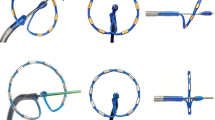Abstract
Purpose
Previous data showed that pain sensation was common during pulmonary vein isolation (PVI) using an 8-mm radiofrequency (RF) ablation catheter. Pain was more common in the left pulmonary veins (PVs). We characterized the location of pain during PVI using circular multi-electrode ablation catheters.
Methods
Included are all consecutive patients with atrial fibrillation (AF) who underwent PVI using the phased RF PVAC® catheter (Medtronic) or the irrigated nMARQ™ catheter (Biosense Webster) under conscious sedation between July 2011 and March 2015. Site of pain reaction was marked for each patient.
Results
A total of 251 patients (141 PVAC®, 110 nMARQ™) were studied; 214 (85 %) had at least one lesion associated with pain. Gender (r = 0.084, p = 0.186), type of AF (r = 0.048, p = 0.452), age (r = 0.078, p = 0.216), and repeat procedure (r = 0.018, p = 0.78) were not correlated with pain. There was no association between site of pain and catheter type; only 33 % of the painful PVs were also the largest ones (p = 0.5, kappa = 0.03, R = −0.083). One-year freedom from AF was similar for patients with and without painful PVs (p = 0.6). The distribution of pain was as follows: 126 (59 %) left superior PV (LSPV), 28 (13 %) left inferior, 28 (13 %) all PVs, 12 (5.6 %) right superior, 12 (5.6 %) right inferior, 18 (8.4 %) left common, and 2 (0.9 %) right common PV.
Conclusions
PVI using multi-electrode catheters more commonly caused pain sensation in LSPV. There was no influence of catheter type or PV size on pain localization. Our findings, which are similar to those using an 8-mm ablation catheter, imply that location of pain is not catheter dependent but rather a reflection of autonomic physiology.


Similar content being viewed by others
References
Carnlöf, C., Insulander, P., & Jensen-Urstad, M. (2014). An active supply of analgesics during pulmonary vein isolation reduces pain. Scandinavian Cardiovascular Journal, 48(1), 35–40.
Di Biase, L., Conti, S., Mohanty, P., Bai, R., Sanchez, J., Walton, D., et al. (2011). General anesthesia reduces the prevalence of pulmonary vein reconnection during repeat ablation when compared with conscious sedation: results from a randomized study. Heart Rhythm, 8(3), 368–372.
Cho, J. S., Shim, J. K., Na, S., Park, I., & Kwak, Y. L. (2014). Improved sedation with dexmedetomidine-remifentanil compared with midazolam-remifentanil during catheter ablation of atrial fibrillation: a randomized controlled trial. Europace, 16(7), 1000–1006.
Timmermans, C., Ayers, G. M., Crijns, H. J., & Rodriguez, L. M. (2003). Randomized study comparing radiofrequency ablation with cryoablation for the treatment of atrial flutter with emphasis on pain perception. Circulation, 107, 1250–1252.
Alaeddini, J., Wood, M. A., Parvez, B., Pathak, V., Wong, K. A., & Ellenbogen, K. A. (2007). Site localization and characterization of pain during radiofrequency ablation of the pulmonary vein. PACE, 30, 1210–1214.
Defaye, P., Kane, A., Jacon, P., & Mondesert, B. (2010). Cryoballoon for pulmonary vein isolation: is it better tolerated than radiofrequency? Retrospective study comparing the use of analgesia and sedation in both ablation techniques. Archives of Cardiovascular Disease, 103, 388–393.
Wieczorek, M., Hoeltgen, R., Bruek, M., Bandorski, D., Akin, E., & Salili, A. R. (2010). Pulmonary vein isolation by duty-cycled bipolar and unipolar antrum ablation using a novel multielectrode ablation catheter system: first clinical results. Journal of Interventional Cardiac Electrophysiology, 27, 23–31.
Shin, D. I., Kirmanoglou, K., Eickholt, C., Schmidt, J., Clasen, L., Butzbach, B., et al. (2014). Initial results of using a novel irrigated multielectrode mapping and ablation catheter for pulmonary vein isolation. Heart Rhythm, 11(3), 375–383.
Packer, D. L., Kowal, R. C., Wheelan, K. R., Irwin, J. M., Champagne, J., Guerra, P. G., et al. (2013). Cryoballoon ablation of pulmonary veins for paroxysmal atrial fibrillation: first results of the North American Arctic Front (STOP AF) Pivotal Trial. American College of Cardiology, 61(16), 1713–1723.
Verma, A., Debruyne, P., Nardi, S., Deneke, T., DeGreef, Y., Spitzer, S., ERACE investigators, et al. (2013). ERACE trial. Circulation. Arrhythmia and Electrophysiology, 6(5), 835–842.
Eitel, C., Hindricks, G., Sommer, P., Gaspar, T., Kircher, S., Wetzel, U., et al. (2010). Circumferential pulmonary vein isolation and linear left atrial ablation as a single-catheter technique to achieve bidirectional conduction block: the pace-and-ablate approach. Heart Rhythm, 7, 157–164.
Armour, J. A., Murphy, D. A., Yuan, B. X., MacDonald, S., & Hopkins, D. A. (1997). Gross and microscopic anatomy of the human intrinsic cardiac nervous system. Anatomical Record, 247, 289–298.
Armour, J. A. (2004). Cardiac neuronal hierarchy in health and disease. American Journal of Physiology. Regulatory, Integrative and Comparative Physiology, 287, R262–R271.
Huang, M. H., Negoescu, R. M., Horackova, M., Wolf, S., & Armour, J. A. (1996). Polysensory response characteristics of dorsal root ganglion neurones that may serve sensory functions during myocardial ischemia. Cardiovascular Research, 32, 503–515.
Thompson, G. W., Horackova, M., & Armour, J. A. (2002). Role of P1 purinergic receptors in myocardial ischemia sensory transduction. Cardiovascular Research, 53, 888–901.
Armour, J. A., Huang, M. H., Pelleg, A., & Sylvén, C. (1994). Responsiveness of in situ canine nodose ganglion cardiac afferent neurons to epicardial mechanoreceptors and/or chemoreceptor stimuli. Cardiovascular Research, 28, 1218–1225.
Herr, K. A., & Garand, L. (2001). Assessment and measurement of pain in older adults. Clinics in Geriatric Medicine, 17, 457–458.
Breivik, H., Borchgrevink, P. C., Allen, S. M., Rosseland, L. A., Romundstad, L., Hals, E. K., et al. (2008). Assessment of pain. British Journal of Anaesthesia, 101, 17–24.
Acknowledgments
No financial support was received for this study.
Author information
Authors and Affiliations
Corresponding author
Ethics declarations
The study protocol was approved by our institution review board and was not influenced by Medtronic or Biosense Webster companies.
Informed consent
All patients provided an informed consent prior to the procedure.
Rights and permissions
About this article
Cite this article
Laish-Farkash, A., Katz, A., Cohen, O. et al. Site localization of painful lesions during radiofrequency ablation of pulmonary veins using circular multi-electrode catheters. J Interv Card Electrophysiol 45, 63–69 (2016). https://doi.org/10.1007/s10840-015-0065-6
Received:
Accepted:
Published:
Issue Date:
DOI: https://doi.org/10.1007/s10840-015-0065-6




